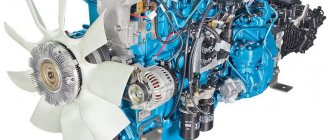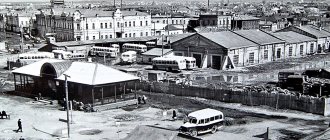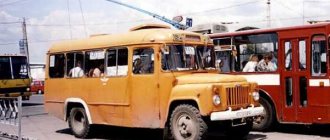Maxim Shelepenkov, photos and copies of documents from the AMO ZIL Museum
In the history of the domestic automotive industry, so many myths have accumulated that, having wandered for decades from book to book, from magazine articles to scientific works and vice versa, they have become so persistent and familiar that no one is trying to look for primary sources and independently figure out what is true and what is not. lie.
Let's start from the beginning. The Moscow Likhachev Automobile Plant became famous for the fact that, according to the official version, it was the first to master the production of Soviet cars and became the flagship of the Soviet automobile industry. And keeping in mind the revolutionary past of the plant, more than one book, and especially more than one magazine article, was devoted to its history.
During the Soviet era, due to state ideology, some facts from the history of this plant were rewritten, and many were deliberately kept silent. It's clear. But even more was lost or changed due to the negligence and incompetence of the authors taking on historical publications. Restoring the truth today is incredibly difficult. And the point is not even in the search for original documents, but in the resistance of public opinion - they are rewriting history again!
Until the twentieth century
Few people remember that in 1791, the famous mechanic Ivan Kulibin introduced a three-wheeled cart with steering and a 3-speed gearbox, innovative for that time. Its maximum speed was as much as 10 km/h. True, instead of an engine, the legs of a special servant were used, who pressed the pedals. In 1896, Russians Peter Frese and Evgeniy Yakovlev presented to the public their “self-propelled carriage,” which they created in the image and likeness of the German “Velo” production. But there were also differences. In particular, our engine was 2 hp. s., while engineers from Germany developed only an internal combustion engine with 1.5 liters. With.
Unfortunately, after Yakovlev's death, Frese lost the opportunity to use domestic engines, and had to order them in French. And in 1910, he bought the Russian-Baltic Plant factory from Frese, where they began to mass produce bodies for Russo-Balt trucks.
“Scooter cart” by Kulibin
“Self-propelled carriage” by Yakovlev and Frese
1910s
So, truck engineering began its development in the last decades of imperial Russia. But only the most far-sighted saw the prospects of this industry. Even the government did not immediately appreciate the possibilities of using such technology. But in 1915, the brothers Stepan and Sergei Ryabushinsky (managing their own family factories) began to prepare a springboard for mass production of trucks. Right at the height of the First World War, when the Russian army needed such vehicles. The tsarist government initially hastily began to purchase them from allied countries, and then Messrs. Ryabushinsky, together with engineer Alexander Kuznetsov, proposed setting up their own production. Having secured financial support from the authorities, the trading house “Kuznetsov, Ryabushinsky and Co.” founded the Joint-Stock Moscow Company (AMO), and on August 2, 1916, the foundation stone for the future plant took place. By that time, a general agreement had already been concluded with the Main Military-Technical Directorate for the supply of 1,500 units of equipment (the Italians did not allow the production of more than that under the terms of the license).
Naturally, it was not possible to quickly build the enterprise, nevertheless, the entrepreneurs purchased new machines in America, and some of them were ready for work. The other part was destroyed as a result of a terrorist attack on a ship in the port. The very next year, at a non-launched plant, the “screwdriver” assembly of the Fiat 15 Ter model from Italian components began under license.
Fiat 15 Tier gave life to the future Likhachev plant
During 1917, AMO produced 432 trucks of this series at its still weak capacity. At the same time, more than two weeks were lost due to an uprising of revolutionary-minded workers, whom the enterprise management wanted to send to the front. They did not agree and seized the building. The conflict seemed to have been resolved, but the number of complainers grew. In August, the military forced the obstinate ones out of production and took their places, but they were not going to give up. An open confrontation began. The Ryabushinskys emigrated to France. Since the fall, the construction of the enterprise was practically not carried out due to the outbreak of the revolution, however, the assembly of machines continued in 1918 and even in 1919. Until we run out of details. At the same time, at the still unfinished plant, they tried to repair worn-out trucks produced by the White Motor Company (USA) and produced kerosene lamps.
What's in your name?
Let's take, for example, the name itself. Today everyone knows that it stands for “Automobile Moscow Society” (sometimes in the literature the variant “Joint-Stock Moscow Society” is also found), and few people wonder whether this is really so. And there is no particular reason for doubt, such a decoding has long been spelled out in the “official” history of the plant and is even found in the modern name of the enterprise - AMO ZIL. Only bad luck, no “Automobile Moscow Society” (and even more so a “Joint Stock Moscow Company”) never existed in nature, at least this is what all the pre-revolutionary documents of the automobile plant testify to. Then what does the abbreviation AMO stand for?
In documents of 1916–1917 the enterprise is officially called everywhere “Moscow Automobile Plant of the Kuznetsov, Ryabushinsky and Co. Partnership”, or simply “Moscow Automobile Plant” (for example, on the company’s letterhead, printed in a typographical manner). However, if we are to be punctual, then in the documents of that time it is written somewhat differently than now: “Partnership on shares of the Moscow Automobile Plant.” This is where the abbreviation “AMO” came from. It is not for nothing that the abbreviation “AMO” was always placed in documents after the name. It is not surprising that over time, having forgotten about the old pre-revolutionary spelling, in our time they tried to decipher “AMO” by all available means, coming up with the “Automobile Moscow Society” along the way.
1920s
The next round of development for the enterprise was brought about by the Soviet government's awareness of the need to develop its own mechanical engineering. The Council of Labor and Defense ordered the plant to develop and build trucks. On April 30, 1923, the enterprise received the name of the communist Paolo Ferrero, who was tortured when Mussolini came to power in Italy. They tore him to pieces, tied him by the leg to a Fiat-15 Ter truck and dragged him through the streets. The renaming of the plant where the cars that killed Ferrero were assembled seemed a little ridiculous. And the USSR was not going to pay the Fiat plant for the assembled trucks. In the same year, the perked up designers Tsipulin and Vazhinsky (15 years later they were shot “as a reward”) studied the Italian drawings and tried to create their own model.
“Many repair technology operations were performed manually. For example, first they drilled something similar to a crankshaft into a steel plate and cut out something similar to a crankshaft with a chisel, and then with great tricks they turned the workpiece on a lathe, turning it into a finished product,” recalled Oleg Kurikhin, the now deceased leading researcher at the Polytechnic Museum.
By November 1924, the first AMO-F-15 was created. It is clear that in fact it was an Italian truck, only assembled from domestic iron. Well, the shape of the hood was slightly different. There was also the first accident due to improper manufacturing of the steering ball pin. Nevertheless, during the first 6 days of November, workers assembled the first batch of these machines around the clock. On November 7, three out of ten cars took part in the parade on Red Square. The Soviet government was proud of the achievement, and until the 30s of the last century, not only the truck, but also the bus on its chassis was mass produced (we wrote about this in detail in No. 3 for 2014 - Editor's note). Of course, engineers worked on modernization. Already in 1927, when Ivan Likhachev became the head of the plant, side windows appeared in the cab, a vacuum fuel pump appeared in the fuel system (before that, gasoline flowed by gravity from the tank located above the carburetor), the clutch was replaced from a “wet” multi-disc to a “dry” with two disks. In 1928, the fuel tank was again placed higher to allow gasoline to flow into the engine itself. But they installed a battery, a starter, a horn and electric headlights.
Special-purpose vehicles were also produced on the AMO-F-15 chassis
In 1958, the 722nd K-51 truck crane arrived in Siberia...
AMO-F-15 was essentially the same Fiat 15 Tier
TD "Kuznetsov, Ryabushinsky and Kº"
The next stumbling block for all researchers of the history of the Moscow Automobile Plant is the agreement with the Main Military-Technical Directorate (GVTU), which gave impetus to the construction of the enterprise. The problem is that not everyone turned to the original agreement, and repeated rewriting led to a distortion of its original meaning.
Most often it is mentioned that the plant under construction was designed for the annual production of 1,500 cars. Less often they add that these should be not only trucks, but also FIAT cars. Even less commonly, the Hotchkiss brand is added. So what was actually written into the contract?
Let's turn to the original source and try to restore the truth. Let's start with the fact that the document itself, signed on February 27, 1916, was called the “Agreement on the supply of automobiles” (and not at all on the construction of a car plant) and provided for the supply by the Trading House “Kuznetsov, Ryabushinsky and Co.” to the main military-technical department of “seven hundred and fifty (750) staff (passenger) vehicles and seven hundred and fifty (750) three-ton trucks. Only 1,500 pieces worth 27 million rubles.” An advance of 11,156,250 rubles was issued for the construction of the plant. against future supplies, of which 8.1 million in foreign currency for the purchase of equipment and automotive materials abroad.
It is often said that Ryabushinsky and Co. hoped to build the plant with government money. But this is not true at all. The construction of the plant’s production buildings alone cost 8 million rubles, and it was also necessary to purchase expensive equipment, materials and auto components for building cars, and pay wages to workers and employees. In reality, the cost of building the plant far exceeded the funds allocated from the state treasury.
According to the agreement, the Trading House undertook “when executing cars, to take as the basis for the development of drawings the car brand, “Hotchkiss” or others determined by the head of the State Technical University.” At the same time, the supplier assumed obligations to complete the delivery to build and equip a plant and launch it no later than October 7 of the same year, 1916. The first 10% of the ordered cars were to be provided to GVTU by March 7, 1917, and the entire delivery would end by 1 August 1918. To get rid of import dependence, the agreement limited the presence of only 10% of imported components in manufactured cars, the rest must be produced in Russia.
From the document it becomes clear that there was no talk of any 1,500 cars annually. The agreement provided for a one-time supply of such a number of cars to the army and did not guarantee further post-war cooperation, although it implied it.
The design or brand of the cars, as is commonly believed, was not strictly stipulated in the contract - here the entrepreneurs had room for maneuver, which they did not fail to take advantage of. When it became clear that, despite the measures taken, difficulties with placing orders for equipment abroad would inevitably lead to delays, then on July 7, 1916, the AMO board submitted an application to the Manager of Automotive Plants requesting a legal deferment on the main obligations (the agreement provided such an opportunity and, contrary to popular belief, did not threaten AMO with a large penalty), and in order not to leave the Military Department without cars, it proposed to count 150 one and a half ton FIAT-15ter trucks as 10% of the first delivery (preference was given to this vehicle rather than the 3-ton provided earlier in the contract). The day before, the board of AMO agreed to purchase 180 one-and-a-half-ton FIAT-15ter chassis from FIAT (150 in the form of finished cars, and 30 in the form of a mandatory set of spare parts for them). After some time, AMO was forced to repeat the deal, additionally ordering FIAT-15ter vehicle kits from Italy, since the plant’s readiness to produce cars still left much to be desired.
In Soviet times, this fact was presented as an attempt by the plant owners to avoid producing cars on their own and to follow the path of least resistance by organizing only a “screwdriver assembly.” Of course, this somewhat facilitated AMO’s task of supplying vehicles, but the main motive was the desire to fulfill the previously assumed obligations by any available means and provide the Military Administration with the vehicles necessary for the front. After all, the board of AMO could not have been involved in this and, like other automobile plants under construction, could have blamed everything on the prevailing circumstances.
1930s
By 1930, the renamed “First State Automobile Plant” came up with the well-functioning production of just one model. Everyone understood that there was an urgent need for reconstruction, the decision about which was made “at the top.” The fact is that the cost of the AMO F-15 exceeded the price of foreign trucks, even taking into account delivery, due to the use of non-ferrous metals. In 1930, American engineers appeared at the enterprise, teaching Soviet “screwdriver” assembly of their Autocar Dispatch SA models under the AMO-2 brand. Another American one is engaged in the reconstruction of the premises and equipment of the enterprise. Everything is going well, but a year later the Americans are actually being abandoned, and under the leadership of Likhachev, the workers themselves are finishing what the foreigners started.
In 1931, the company was renamed again. This time to the Stalin plant. By this time, engineers had learned to make AMO-2 from domestic parts and were releasing a new model, AMO-3 (visually no different from American products). Over the next three years, numerous changes were made to the design due to complaints from owners. These innovations formed the basis of the new ZiS-5 model, which was indeed “head and shoulders” ahead of the AMO-2 in terms of strength and fault tolerance. In 1933, the vehicle was tested and the following year went into mass production along with the three-ton ZiS-6. It was on the basis of this model that the famous Katyushas fought with enemy equipment during the Second World War.
AMO-3 looked the same as AMO-2
AMO-3 was assembled from domestic spare parts, unlike AMO-2
By the way, in 1931, it was ZiS that first implemented a domestic hydraulic brake drive, and in 1934, a 12-volt equipment system. The year 1936 was marked by the equipping of prototypes of the ZiS-101 passenger car with an 8-cylinder engine and a radio receiver - these developments were later useful in trucks.
In the meantime, the plant was planning a global modernization and expansion of space. Instead of 90 hectares, the machines will produce on 500 hectares. For this purpose, two lakes and many ravines were filled in on the territory of Tyufelovaya Grove. Along the way, the enterprise produced cars and buses in the old workshops.
In 1937, the plant began producing ZiS-10 truck tractors based on the fifth model. Until 1939, extended chassis - ZiS-11, 12 and 14 - saw the light of day. And under the index 13, the first gas engine unit was released. A little later, the car was modified and released as the ZiS-21 model. The main advantage of these models was the fuel - they were propelled by the gas released as a result of the combustion of wooden blocks.
In the ZiS-5 model, the designers tried to correct all the errors of the AMO-3
The ZiS-10 tractor appeared as a continuation of the ZiS-5
The ZiS-13 used a gas engine unit for the first time
Plant named after Likhachev (AMO ZIL). Part 1
“Even in the years of famine, workers thought not only about bread, potatoes, butter, sugar, from the lack of which they suffered along with their families. They showed a keen interest in the production activities of the plant. Hungry and naked people dreamed of seeing the plant big and strong - a factory of Soviet cars. » excerpt from the book – “History of the Moscow Automobile Plant named after I.A. Likhachev."
Moscow automobile factories are like huge whales washed ashore. One whale - JSC Moskvich, having suffered, has already given its soul to God. Another whale, the Likhachev Plant (ZIL), is still alive, although this is not immediately noticeable. Its huge territory of 275 hectares (for comparison, the area of the All-Russian Exhibition Center is 240 hectares) is divided into two parts by the small ring of the Moscow Railway. In each part there are abandoned and working workshops. There are a carriage and a small cart of photographs of dead ZIL workshops on the Internet, so we decided to add variety and show the plant from the living side, while simultaneously telling about its history. For this purpose, a body shop was chosen, whose guards slept soundly at night.
A series of defeats for the tsarist army during the First World War in 1915 showed the government of the Russian Empire that war requires not only manpower, ammunition and weapons, but also technical equipment - cars, tractors and airplanes. The vehicle fleet at the beginning of the war was very meager, and to increase it, the War Ministry allocated huge funds for the purchase of vehicles from other countries. But the factories of England, Italy and France were busy meeting the needs of their own armies, and accepted orders from the Russian Empire only for small batches of cars. As a result, in addition to the acute shortage of cars, the vehicle fleet was very diverse, which forced the creation of a huge number of front-line and rear workshops for repairing equipment and manufacturing spare parts. The most logical way out of the difficult situation was to start building our own factories, and on February 21, 1916, Nicholas II approved the decision of the Council of Ministers to issue loans for the construction of Russian automobile factories. Five days later, an agreement is signed between the Kuznetsov, Ryabushinsky and Co. Trading House and the Main Military Technical Directorate (GVTU) for the construction of an automobile plant in Moscow and the supply of 1,500 vehicles. For these purposes, the Automobile Moscow Society (AMO) is being organized.
March 1, 1916 P.P. von Derviz sold 138 thousand square fathoms of his dacha in Tyufelovaya Grove for the construction of a plant. The location was chosen very well, the Moscow River flowed nearby, and the Simonovo and Kozhukhovo railway stations were nearby. On August 2, 1916, a solemn prayer service and the official laying of the plant took place in Tyufelevaya Grove, although its construction had already been underway since the spring.
The founders of AMO tried to attract the best specialists in the automotive industry. It was possible to find the necessary personnel among the employees of the Russian-Baltic Wagon Works (RBVZ), which was evacuated from Riga to Moscow due to military operations. Having lured engineers from RBVZ to AMO, they entered into an agreement to pay penalties in the event of unauthorized refusal to serve, so that they would not return. Other qualified employees of the Russian-Baltic Plant followed the engineers. The first director of the AMO plant was [Dmitry Dmitrievich Bondarev (1878 - 1937)], who at one time headed the automotive department of RBVZ.
So, a good site for the plant has been selected, engineers have been hired, now it’s time to design a car and create equipment for their production. There was no opportunity to develop a domestic car from scratch, since under the terms of the agreement with the State Technical University, the supplier was obliged to use FIAT car drawings when designing and “by March 7, 1917, at least 10 percent of the entire supply (150 cars) must be manufactured.” . Therefore, the basis is taken from the Italian 1912 model, which was designed for the Italian army to be used in off-road conditions. For the Russian similarity of roads, this is an ideal option. Having concluded an agreement in Turin with the company for the right to produce a one-and-a-half-ton cargo truck and a passenger car in Russia with all the necessary technical and working drawings, AMO shareholders began ordering equipment.
This is where the first difficulties arose. It was impossible to create the necessary equipment in Russia. Therefore, AMO representatives were sent to England, America and Sweden to place orders for machines. For example, all metalworking machines, accessories and conductors for them for mechanical and tool workshops were ordered in America. Ordering is only half the battle; you also need to deliver them.
In order to load equipment onto a ship and send it from America to Russia, special permission was required from the Russian Committee on Military Orders in New York. It took a lot of time to obtain permits, and even after receiving them and loading the machines onto the ship, there were no guarantees that the cargo would reach its destination safe and sound. In the Russian Empire, ports and railways were overloaded because cargo for the military was transported to the front through them. And even if by some miracle the equipment got on the train, it could get lost along the way or arrive partially stolen. Sometimes the equipment did not reach the recipient for more terrible reasons. On October 23, 1916, the steamship Baron Driesen from New York arrived at the Arkhangelsk port of Bakaritsa for unloading with 3,700 tons of cargo, including machine tools for the AMO plant and 1,600 tons of explosives. On October 26, 1916, at about one o'clock in the afternoon, a bomb planted by a boatswain in the hold of the ship exploded. The first explosion was followed by a second - boxes with explosives that had previously been unloaded from the ship detonated. In an instant, the steamer, AMO machines, neighboring ships, and port buildings turned into a pile of rubble. The building and things are not a pity, everything can be restored, but the 607 people who died in this hell cannot be returned. Boatswain Pavel Polko was sentenced to death by hanging for committing sabotage.
In Tyufelevaya Roshcha, too, not everything was smooth; construction materials were delivered to the construction site intermittently and there was a shortage of labor. The founders had to contact the military committee with a request to provide prisoners of war for construction work. The request was granted and 250 prisoners of war arrived for construction. In total, 2,167 people were involved in the construction of the plant in the fall of 1916.
The difficulties that arose could lead to failure to fulfill the terms of the contract for the supply of the first 150 vehicles, and for this they would have to pay a very substantial penalty to the Main Military Technical Directorate. Therefore, in order to meet the deadline, AMO shareholders purchase sets of parts for cars in Italy and set up “screwdriver” assembly of cars in Moscow.
The year 1917 arrived. The growth of revolutionary sentiment in the country reached its maximum. But at the beginning of the year, the workers of the AMO plant were not yet strongly swayed by Bolshevik propaganda, as they were afraid of losing their jobs and going to the front (the plant was considered a defense plant and work at it replaced being sent to the front). In spring everything starts to change. The Ryabushinskys decide to fire a number of workers involved in the construction of workshops, under the pretext that the plant is almost completed and so many builders are no longer needed. Naturally, the choice fell on the revolutionary-minded workers, who did not like it and protested. The management was unable to cope with the protest and left the employees in their jobs, although reducing everyone’s salaries. In May, the plant's executive committee decides to complain to the Central Conflict Commission under the Moscow Council of Workers' Deputies about the low level of wages. But to his great surprise, the Moscow Council takes the side of the plant management and recommends firing unnecessary workers, and using their salaries to increase the salaries of those employees who are engaged in assembling cars. The workers again did not like the prospect of being left without money and going to the front, and on May 3 they seized the plant. The rioters forcibly take out director D.D. Bondarev in a wheelbarrow to the tram stop, then they catch the head of the forging and pressing department - engineer Makarovsky, repeating the same execution with him. For two weeks, the AMO plant was in the hands of the workers until a compromise was found: no one would be fired, salaries would be increased, and the rioters should apologize to Bondarev and Makarovsky. Despite this, the director never returned to the plant.
Attempts to fire construction workers continued until the summer. Everything was decided on July 22, 1917, when the main military-technical department, at the request of the founders of the AMO, sent soldiers to the plant, who removed fired workers from the plant and took their places in the assembly of Fiat trucks. In August, the military administration decided to immediately retrain the plant into a large car repair shop and reduce workers to the required minimum. As you probably understand, no one was going to leave the plant and the closed workshops were opened without permission by those eager to continue working. By the fall, the influence of the Bolsheviks among the working class at the AMO plant became overwhelming. A factory detachment was created, which was trained in the tactics of street fighting, digging trenches, etc. In October, with the help of the Bolsheviks among the AMO employees, the Military Revolutionary Committee created an automobile detachment, which was supposed to transport ammunition and evacuate the wounded during the revolution.
Fiat assembled by the AMO plant in the service of the Military Revolutionary Committee during the days of the October Revolution.
The October Revolution thundered. The AMO plant now belonged to the Ryabushkins only on paper; in fact, it was managed by the executive committee. The first step was an attempt to establish discipline at the plant in order to stop theft and indifference to the plant’s property. But nothing came of it, the workers considered the plant to be someone else’s, and continued to steal and work sloppily. In order to stop this, workers had to be assigned to each workshop to monitor discipline. The second important thing was to reduce the plant’s expenses, because after the revolution, dismissed employees returned to the plant and needed to be paid salaries. Since the workers had the cash register and board documents, after digging through them, they found the AMO plant’s obligations to foreign companies that supplied parts and equipment in the amount of 6 million rubles. The generous proletariat forgave their debts to foreigners and refused to pay them anything, thereby saving money.
In March 1918, in parallel with the assembly of Fiat cars (assembly was carried out from the remaining sets of parts purchased by the Ryabushkins in Italy), the plant began to repair and manufacture bodies based on imported White and Fiat chassis. Trucks with a carrying capacity of 1.5 and 3 tons, the American brand [WHITE] significantly replenished the vehicle fleet of the Russian Empire during the First World War. In total, the American company sent about 18,000 trucks to the allies, some of which went to Russia. I can assume that after the defeat of the RSFSR in the First World War, front-line vehicles began to arrive at factories for repairs (at that time, out of approximately 8,000 cars in the RSFSR, about 35% were running, and even those that were running were in a deplorable condition) . By restoring these machines, AMO plant workers begin to independently produce the parts necessary for repair.
On August 15, 1918, a decree on nationalization was issued. Thus, approximately 75% completed and with about 500 of the latest American machines, the plant became state-owned.
In 1919, the plant ran out of the last sets of parts for assembling Fiat cars, purchased during the management of the Ryabushkins (in just three years the plant produced 1319 Fiat cars: 432 in 1917, 779 in 1918 and 108 in 1919). Due to the civil war, there are fewer and fewer workers left at the plant, there is no longer any discipline, and there are fewer and fewer qualified personnel.
The shortage of specialists was acutely felt when in January 1920, the AMO plant was assigned the task of making engines for the first Soviet tanks. Having involved experienced engineers who had worked under the Ryabushkins, the AMO plant coped with the task and, by slightly changing the Fiat truck engine, they made 24 tank engines. The tank that was ultimately made received a very unique name - “Freedom Fighter Comrade Lenin” and was an exact copy of the French Renault FT-17 tank.
On the left is the French tank Renault FT-17, on the right are AMO employees near the model of the first Soviet tank “Freedom Fighter Comrade Lenin” 16. On February 25, 1921, the Council of Labor and Defense decided: “To instruct the Presidium of the Supreme Economic Council to conclude an agreement with a group of American workers on the surrender of Petrograd, and if this turns out to be impossible, transfer to them the AMO plant in Moscow, which meets the technical conditions.” On March 2, 1921, the plant management agreed with the advisability of transferring the plant to American mechanics to organize mass production of new cars there. Perhaps this was the only way to get away from artisanal production. In May there is a change of director, instead of [Vladimir Ivanovich Tsipulin (1882 -1940)] [Arthur Aleksandrovich Adams (1885-1969)] starts work.
On December 18, 1922, in Turin, the Italian communist Pietro Ferrero, who worked for, was brutally murdered by the fascists. His body was so mutilated that he could only be identified using documents. This is not surprising, because they killed him by tying his leg to a truck, which began to drive around the city. It’s probably not very clear what the description of this event has to do with it, but I’ll explain. On April 30, the AMO plant is renamed in honor of the man who died in Turin. It seems strange to me that the workers’ decision to name a plant producing trucks in honor of a man who was brutally murdered with a truck, especially since there is a possibility that the Nazis used a Fiat truck, and the AMO plant was producing just these trucks.
In the summer of 1923, another change of director took place, now instead of A.A. Adams plant named after. Ferrero is managed by G.N. Korolev. Also, TsUGAZ (Central Administration of State Automobile Plants) approves a production plan for 1923-1927, which gives the go-ahead for the creation of new cars, and not just the repair of old ones. The plant, having received instructions, begins to prepare the production line, and begins the installation of machines and equipment that has stood untouched since the time of the Ryabushinskys. There was no documentation for the equipment, so everything was done at random. Despite the fact that the production plan was handed over to the plant on June 30, 1923, it was only in March 1924 that an agreement was signed with the plant for the production of new 1.5-ton Fiat trucks. Director of the plant named after. Ferrero G.N. On March 15, 1924, Korolev signed an order to begin preparatory work for the production of trucks. The plant revived sharply, because by April 1 it was necessary to provide a list of missing equipment to produce 1,200 cars a year, and by May 1, draft estimates for all construction and repair work at the plant. Ideally, it was planned to begin production of the truck in August 1924.
The first Soviet truck was called AMO - F15 and was an almost exact copy of the FIAT 15 Ter, for the production of which the plant was built. The chief designer of the new car becomes the former director V.I. Tsipulin, he is assisted by the designer E.I. Vazhinsky (at the end of the 30s, the Soviet government “thanked” the designers by shooting them). Despite the fact that the plant had two reference trucks and drawings, we had to figure out a lot on our own. As a result, it was not possible to start car production by August 1924, and it was decided to coincide with the release of the first 10 cars to coincide with the anniversary of the October Revolution. On the night of November 1, the first car was ready. It was only possible to start it the second time. On the morning of the same day, V.I. Tsipulin, with the assemblers, drove the first Soviet truck on its first test run around Moscow and got into the first accident. While driving, the steering ball pin burst, causing Tsipulin to lose control of the car. Fortunately, no one was injured in the accident and the car was towed to the workshop, where they found out that the cause of the breakdown was that the pins were made from the wrong grade of steel. Within 24 hours, the entire defective batch was replaced. On November 6, the assembly and painting (in bright red) of the tenth car was completed. The seventh anniversary of the October Revolution, after the successful demonstration of AMO-F15 trucks on Red Square, became the birthday of the Soviet automobile industry.
In 1925, the plant named after. Ferrero is renamed the 1st State Automobile Plant. In the same year, regular failure to fulfill the plan forced TsUGAZ to once again change its director. Now the head of the plant is F.I. Kholodilin, but he was unable to hold this position for a long time; in December 1926, a decision was made to appoint a new director, I.A. Likhachev, who began work on January 1, 1927.
The period from 1925 to 1927 finally demonstrated to the country's leadership the crisis in the automotive industry. Let me give you some numbers for clarity. In the USSR in 1925 there were 24,218 vehicles, of which 14,440 were in use. In America there was 1 car for every 6 people, in England for 80 people, in France for 72 people, in Germany for 250 people, in the USSR 1 car per 11,000 people. The 1st State Automobile Plant (formerly AMO) tried its best, in 1924/25 it produced 100 cars, in 1925/26 - 275, 1926/27 - 425, 1927/28 - 580, and this provided that the steel was from metallurgical factories had colossal defects, which sometimes reached 55%. It is clear that for the scale of the country, the production of such a number of cars is a drop in the bucket. This drop was also very expensive, the cost of the first 10 cars was 18,000 rubles apiece (the average salary at that time was 66 rubles), obviously no one would buy for that kind of money, because the cost of foreign cars was significantly lower (average the price of cars in America was 3,000 rubles, a Ford T cost 800 - 900 rubles in the USSR). Therefore, the state set the price for AMO F15 at 8,850 rubles, and paid the difference at its own expense. The plant tried in every possible way to reduce the cost of cars, already the second batch cost 13,000, the 3rd 11,700, and in 1926/27 the plant even made a profit, but still similar cars from America, taking into account delivery, cost 30-35% less. In mid-1927, a discussion developed on the pages of the Pravda newspaper about the advisability of the widespread introduction of cars in the country. Opponents of the introduction argued that for the Soviet off-road system nothing was needed except carts, while defenders believed that an increase in the number of vehicles would also lead to a fight against off-road conditions.
All of the above problems had to be solved, and at the XV Congress in December 1927, a decision was announced on a major expansion and reconstruction of the 1st GAZ. The updated plant should produce at least 10,000 one-ton and 4,000 one-and-a-half-ton cars per year, working in three shifts. The plant expansion project was undertaken by V.I. Tsipulin, other designers and engineers went on business trips to developed countries to gain experience, order machine tools and select a machine on the basis of which the new production will be based. In 1928, work on the Tsipulin project was suspended due to its impracticality and a directorate for the expansion and reconstruction of the AMO plant (URRA) was created. Led by M.L. Sorokin. At the same time, an agreement is signed with the American company [Autocar] to provide drawings and assistance in organizing production of the car model chosen for the plant. They decided to entrust the reconstruction to the American one, and when the contract was concluded on May 24, 1929, the scale of production was already different from what was announced at the XV Congress. Now, after reconstruction, the plant should produce 25,000 cars with a carrying capacity of 2.5 tons per shift and the cost of cars should drop to 4,000 rubles. American engineers arrive at the plant to carry out reconstruction. A year later, the contract with the Americans was terminated and plant director I.A. became the head of the URRA. Likhachev. On October 1, 1931, the plant was officially launched after reconstruction and renamed again, now it is the Stalin Plant (ZIS). During two years of reconstruction, the plant’s area increased 5.5 times, as I.A. said. Likhachev: “We actually sewed the coat to the button.”
While reconstruction was underway, the plant did not stand still and continued to produce cars. In parallel with the production of the AMO-F15, the plant began production of the AMO-2 car (produced from 1930 to 1931, a total of 1,715 units were produced), which is a copy of Autocar Dispatch SA. It was assembled from foreign units. On October 25, 1931, the first 27 cars after reconstruction rolled off the main assembly line of the Stalin plant. They are almost exact copies of AMO-2, but are already assembled from domestic units. These cars are called AMO-3. The very first copy was donated to the editorial office of the Pravda newspaper, and the rest of the cars were transferred to the Proletarsky District Committee of the All-Union Communist Party of Bolsheviks of Moscow, the Supreme Economic Council, the All-Russian Central Council of Trade Unions, and Hammer and Sickle.
In just three years of production (1931-1933), 34,969 AMO-3 vehicles were produced. During the entire production period, amendments were made to the car several times. This was due to the fact that car owners could directly write complaints about quality to the plant, which were immediately considered, for example, in the first batch of 1000 cars there were 333 defects, then in the second thousand there were already 118 and decreasing.
Simultaneously with the release of AMO-3, work began on prototype ZIS-5, ZIS-6 and ZIS-8 buses. E.I. worked on the ZIS-5 car. Vazhinsky, who analyzed all the shortcomings of the AMO-3 identified during operation, corrected them and introduced changes into the new car. Thus, the ZIS-5 has become more powerful, more reliable and simpler. The main differences from the AMO-3 were an increase in power, load capacity, increased ground clearance, replacement of the hydraulic brake drive with a mechanical one and lower cost. As a result, the car turned out to be a hit of the Soviet automobile industry, outliving its designer Yevgeny Ivanovich Vazhinsky, who, according to the “good” tradition of the Soviet regime, was shot in 1938.
The first ten experimental samples of ZIS-5 and ZIS-6 were assembled on July 26, 1933 and sent on a 2,500 km long motor rally, of which 700 km was off-road. The mileage was completed without accidents or complaints, and the plant began preparations for the production of these models. Already in the next 1934, in the master plan (production of 20,500 cars), priority is given to the ZIS-5 (18,370 units), ZIS-6 (700 units), ZIS-8 (350 units) models and the production of older models is stopped.
Less than two years after the large-scale reconstruction, car manufacturers began to think about a new reconstruction. In August 1933, the Council of People's Commissars (Union of People's Commissars) of the USSR was considering the issue of a second reconstruction, in which it was planned to expand the territory from 90 hectares to 500, quadruple the amount of equipment and create five times more jobs. Accordingly, there should also be more cars coming off the assembly line - 80,000 units. in year. In March 1934, a master plan for the expansion of the plant was approved. By the end of the month, sites for construction had been selected and approved. The project also provided in advance for measures to supply construction with materials, transport and workers.
The selected areas for the expansion of the plant in Tyufelovaya Roshcha were difficult to develop: many ravines, swamps, several lakes, as well as residential and industrial buildings. By the autumn of 1934, lakes Postyloe and Chernoe, as well as all the ravines, had already been filled in. Land for these purposes was taken from pits for new workshops, and Metrostroy also came to the rescue, bringing 300 metro trains of soil from its facilities in Moscow.
The design and thoughtfulness of the organization of construction work did not help; in the first six months, only 60% of the planned plan for this period was completed. Despite all the efforts made, connecting the plant workers with the builders on cleanup days and improving the organization of construction work, it was not possible to complete the second reconstruction of the plant in two years.
On the night of August 31, 1935, an event occurred that greatly influenced labor productivity in the USSR. It was on this night that Alexei Stakhanov’s team extracted 102 tons of coal in 5 hours and 45 minutes instead of the norm of 7 tons. His example spread among workers at the speed of modern Internet memes. The Stalin plant was no exception. I will give as an example the work of two teams at the crankshaft production site at the plant. On October 10, V. A. Bobkov’s team, changing the operating principle, was able to forge 307 shafts, with the norm being 240 pieces. per shift. The second shift led by F.I. Khromilin, having come to work and learned about her comrades’ record, also joined the race and, redistributing responsibilities, forged 326 shafts during the shift. Stocky, sometimes gloomy, surrounded by a glow from the sides, straightening up, the young Stakhanovite Bobkov throws down the hammer. Two hundred and forty! In the rolls of thunder the boys are not tired of raging. Three hundred and seven without defects or breakdowns! You can wash your face and finish. You cannot find such a style in the world, And there are not enough words for glory. Tonight the stamper Chromilin issued three hundred and twenty-six shafts. The competition did not end there; two weeks later, in the morning, the Chromilin team improved the figure to 341 crankshafts. On the same day, Bobkov’s brigade broke a record - 380 shafts. But Khromilin and his guys did not give up and forged 385 crankshafts in the evening. Competitions of this type were held in all workshops of the plant. Despite the fact that F.I. won this competition. Khromilin in January 1936 V.A. Bobkov was awarded the Order of the Red Banner of Labor. To celebrate, three days after the award, Vasily Bobkov forged 556 crankshafts, although the furnace was already more modern.
In 1935, work began on the first passenger car - the ZIS 101. I. E. Vazhinsky, becoming the chief designer at the plant this year, led the work on the car. The ’33 Buick was used as a basis. The first experimental cars were supposed to be ready by January 25, 1936, but they could not be completed by the deadline, so the “leader of the people” was able to look at the two cars only on April 29, 1936. In general, the top of the party was happy with the car even after making minor amendments , the car was put into mass production. Although the plan for this year included the production of 2000 units. passenger cars, the plant managed to make only 11 units.
In the pre-war period, in addition to trucks and cars, the plant also produced buses. The very first bus was based on the [AMO-F15], later the [AMO-4] appeared, on the extended base of the AMO-3, and since 1934 the ZIS-8.
During two reconstructions there was a significant expansion of the plant, and additional jobs appeared. In 1928, 1,798 people worked at the plant, and by 1940, 39,747 people. This increase in people added to the problems. There weren’t enough hostels, people spent the night in workshops, and sometimes even at the station. At the beginning of 1939, only 19,740 people were provided with housing. The public catering system at the plant has changed significantly. The old canteen could not accommodate everyone, so a new one appeared - the central one, with a capacity of 9,000 people. Canteens and buffets opened in a number of workshops. An important role in providing employees with food was played by the labor supply department, which had five state farms, which ensured the supply of all necessary types of products. The factory school can no longer accommodate everyone, so workshop schools are opening, where they taught directly at the machines. In 1940, at , the largest in the USSR. The plant struggled with illiteracy in every possible way and tried to raise the cultural level of the workers. A library was opened (105,000 volumes), tickets to cinemas and theaters were given out for success in production, and a literary circle was opened. Instead of two medical workers, 17 doctors appeared and a clinic was opened with various medical rooms and equipped with the latest technologies. Kindergartens and nurseries were built and opened for the children of workers. There was a factory rest house “Vaskino”. In 1937, a factory House of Culture was built on the site of the Simonov Monastery necropolis. All this makes ZIS almost a real city, which has everything you need.
1 - based on information from the list of victims of Bolshevik and communist terror in the Soviet Union. To be continued…
1940s
The Second World War made its own adjustments. After the attack on the USSR, the authorities had to urgently evacuate most of the industrial enterprises away from Moscow. In particular, part of the ZiS capacity was transferred to Ulyanovsk and Miass (which in the future turned into UAZ and Ural). They began to produce a “stripped-down” version of the ZiS-5. The model was stripped of its side panels, bumper and one headlight. The brake system also underwent changes, and the cabin was made of wood.
In 1942, the ZiS-42 and ZiS-42M with rear tracked propellers were created for the military industry at a Moscow plant. Both models replaced the previously released ZiS-22, whose rubber-fabric tracks quickly became unusable. But even with intact belts, the maneuverability of the equipment was like “an elephant in a china shop.” And in the snow the car simply stood up, since the snow clogged in the mover prevented the drive wheels from spinning.
In 1946, powered windows and a hypoid final drive in the gearbox were tested on the models being developed.
The production of new civilian trucks was restored only by 1947. The new creation of the designers looked like the American tractors of the 30s. But the ZiS-150 received a 5-speed gearbox, a thermostat, a pneumatic drive in the brake system and fuel consumption reduced to 38 l/100 km (previous models consumed more than 50 liters). Three years later, the car was improved by completely removing wood during the manufacture of the cabin and updating the carburetor.
The Second World War forced engineers to create the ZiS-42 for the front
When developing the ZiS-150, engineers took ideas from their American colleagues











